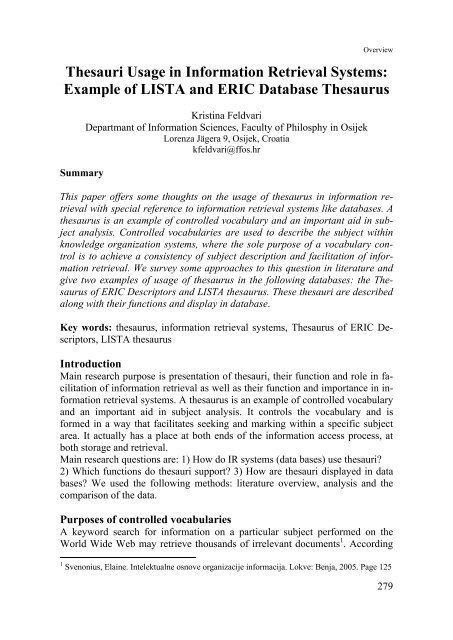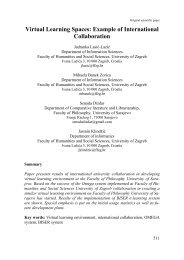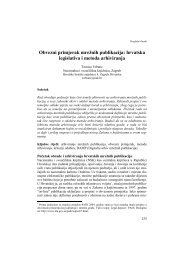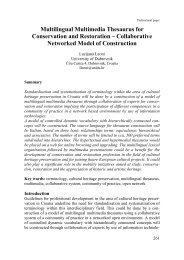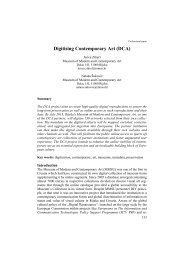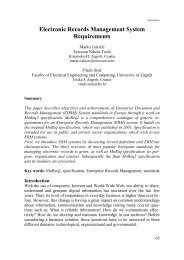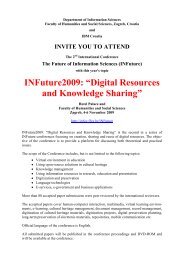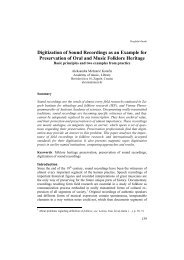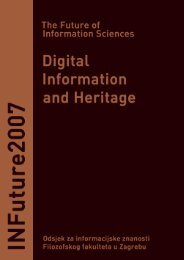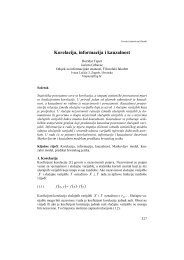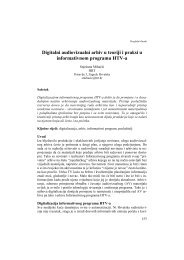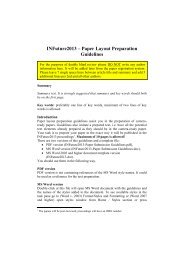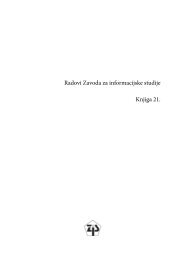Thesauri Usage in Information Retrieval Systems: Example of LISTA ...
Thesauri Usage in Information Retrieval Systems: Example of LISTA ...
Thesauri Usage in Information Retrieval Systems: Example of LISTA ...
Create successful ePaper yourself
Turn your PDF publications into a flip-book with our unique Google optimized e-Paper software.
Overview<br />
<strong>Thesauri</strong> <strong>Usage</strong> <strong>in</strong> <strong>Information</strong> <strong>Retrieval</strong> <strong>Systems</strong>:<br />
<strong>Example</strong> <strong>of</strong> <strong>LISTA</strong> and ERIC Database Thesaurus<br />
Summary<br />
Krist<strong>in</strong>a Feldvari<br />
Departmant <strong>of</strong> <strong>Information</strong> Sciences, Faculty <strong>of</strong> Philosphy <strong>in</strong> Osijek<br />
Lorenza Jägera 9, Osijek, Croatia<br />
kfeldvari@ffos.hr<br />
This paper <strong>of</strong>fers some thoughts on the usage <strong>of</strong> thesaurus <strong>in</strong> <strong>in</strong>formation retrieval<br />
with special reference to <strong>in</strong>formation retrieval systems like databases. A<br />
thesaurus is an example <strong>of</strong> controlled vocabulary and an important aid <strong>in</strong> subject<br />
analysis. Controlled vocabularies are used to describe the subject with<strong>in</strong><br />
knowledge organization systems, where the sole purpose <strong>of</strong> a vocabulary control<br />
is to achieve a consistency <strong>of</strong> subject description and facilitation <strong>of</strong> <strong>in</strong>formation<br />
retrieval. We survey some approaches to this question <strong>in</strong> literature and<br />
give two examples <strong>of</strong> usage <strong>of</strong> thesaurus <strong>in</strong> the follow<strong>in</strong>g databases: the Thesaurus<br />
<strong>of</strong> ERIC Descriptors and <strong>LISTA</strong> thesaurus. These thesauri are described<br />
along with their functions and display <strong>in</strong> database.<br />
Key words: thesaurus, <strong>in</strong>formation retrieval systems, Thesaurus <strong>of</strong> ERIC Descriptors,<br />
<strong>LISTA</strong> thesaurus<br />
Introduction<br />
Ma<strong>in</strong> research purpose is presentation <strong>of</strong> thesauri, their function and role <strong>in</strong> facilitation<br />
<strong>of</strong> <strong>in</strong>formation retrieval as well as their function and importance <strong>in</strong> <strong>in</strong>formation<br />
retrieval systems. A thesaurus is an example <strong>of</strong> controlled vocabulary<br />
and an important aid <strong>in</strong> subject analysis. It controls the vocabulary and is<br />
formed <strong>in</strong> a way that facilitates seek<strong>in</strong>g and mark<strong>in</strong>g with<strong>in</strong> a specific subject<br />
area. It actually has a place at both ends <strong>of</strong> the <strong>in</strong>formation access process, at<br />
both storage and retrieval.<br />
Ma<strong>in</strong> research questions are: 1) How do IR systems (data bases) use thesauri?<br />
2) Which functions do thesauri support? 3) How are thesauri displayed <strong>in</strong> data<br />
bases? We used the follow<strong>in</strong>g methods: literature overview, analysis and the<br />
comparison <strong>of</strong> the data.<br />
Purposes <strong>of</strong> controlled vocabularies<br />
A keyword search for <strong>in</strong>formation on a particular subject performed on the<br />
World Wide Web may retrieve thousands <strong>of</strong> irrelevant documents 1 . Accord<strong>in</strong>g<br />
1 Svenonius, Ela<strong>in</strong>e. Intelektualne osnove organizacije <strong>in</strong>formacija. Lokve: Benja, 2005. Page 125<br />
279
INFuture2009: “Digital Resources and Knowledge Shar<strong>in</strong>g”<br />
to Lancaster the major defect <strong>of</strong> the Internet as an <strong>in</strong>formation source, apart<br />
from its size, is the fact that it lacks any form <strong>of</strong> quality control. 2 We can try to<br />
solve this problem by us<strong>in</strong>g a subject language that <strong>in</strong>corporates measures designed<br />
to improve retrieval <strong>of</strong> the desired <strong>in</strong>formation. <strong>Usage</strong> <strong>of</strong> subject languages<br />
to retrieve <strong>in</strong>formation provides a value-added quality, which, <strong>in</strong> the<br />
case <strong>of</strong> highly ref<strong>in</strong>ed languages, can transform <strong>in</strong>formation <strong>in</strong>to knowledge. 3<br />
A subject language is used to describe what the document is about. The ma<strong>in</strong><br />
purpose it serves are primary those <strong>of</strong> the collocation <strong>of</strong> documents that have<br />
the same <strong>in</strong>formation content and the navigation <strong>of</strong> the users. To achieve the<br />
collocation objective, the language must be designed so as to facilitate the retrieval<br />
<strong>of</strong> all and only relevant documents 4 . This is estimated by the tw<strong>in</strong> measures<br />
<strong>of</strong> precision 5 and recall 6 .<br />
We can name five ma<strong>in</strong> purposes that controlled vocabularies serve:<br />
1) Translation: provide a means for convert<strong>in</strong>g the natural language <strong>of</strong> authors,<br />
<strong>in</strong>dexers, and users <strong>in</strong>to a vocabulary that can be used for <strong>in</strong>dex<strong>in</strong>g and retrieval.<br />
2) Consistency: promote uniformity <strong>in</strong> term format and <strong>in</strong> the assignment <strong>of</strong><br />
terms. 3) Indication <strong>of</strong> relationships: Indicate semantic relationships among<br />
terms. 4) Label and browse: provide consistent and clear hierarchies <strong>in</strong> a navigation<br />
system to help users locate desired content objects. 5) <strong>Retrieval</strong>: serve as<br />
a search<strong>in</strong>g aid <strong>in</strong> locat<strong>in</strong>g content objects. 7<br />
The last purpose is the our research question and will be elaborated <strong>in</strong> the rest <strong>of</strong><br />
this paper.<br />
What is thesaurus?<br />
Def<strong>in</strong>ition<br />
Librarian Lexicon def<strong>in</strong>es thesaurus as a vocabulary <strong>of</strong> key words, i.e., a standardized<br />
set <strong>of</strong> terms and phrases authorized for use <strong>in</strong> an <strong>in</strong>dex<strong>in</strong>g system to<br />
describe a subject area or <strong>in</strong>formation doma<strong>in</strong>. 8 If we take a look at def<strong>in</strong>itions<br />
<strong>of</strong> some authors, e.g. D. Bawden we can notice that he <strong>of</strong>fered def<strong>in</strong>ition <strong>of</strong> the-<br />
2<br />
Lancaster, F. W. Do <strong>in</strong>dex<strong>in</strong>g and abstract<strong>in</strong>g have a future? // Anales de documentation. 2003, 6;<br />
page 137<br />
3 Svenonius, Ela<strong>in</strong>e. Ibid. Page 125<br />
4 Ibid, page 126<br />
5<br />
Recall (R) is the proportion <strong>of</strong> relevant material retrieved and precision (P) is the proportion <strong>of</strong><br />
retrieved material that is relevant.<br />
6<br />
Lancaster, F.W. Index<strong>in</strong>g and abstract<strong>in</strong>g <strong>in</strong> theory and practice. Compa<strong>in</strong>g Illions: University <strong>of</strong><br />
Ill<strong>in</strong>ois, 1998. Page 3-4<br />
7 ANSI/NISO Z39.19-2005. Guidel<strong>in</strong>es for the Construction, Format, and Management <strong>of</strong><br />
Monol<strong>in</strong>gual Controlled Vocabularies. 2005. http://eric.de.gov/ERICWebPortal/resources/html/<br />
help/Z39-19-2005.pdf (2009-07-22)<br />
8 Bibliotekarski leksikon. Beograd: Nolit, 1984. Page 186<br />
280
K. Feldvari, <strong>Thesauri</strong> <strong>Usage</strong> <strong>in</strong> <strong>Information</strong> <strong>Retrieval</strong> <strong>Systems</strong><br />
saurus purpose. He accents that <strong>in</strong> <strong>in</strong>formation retrieval thesaurus limits and<br />
controls the diversity <strong>of</strong> natural languages by <strong>of</strong>fer<strong>in</strong>g an expression that should<br />
be use for each concept 9 while M.L. Nielsen says that thesaurus is a well-known<br />
and well-established tool <strong>in</strong> <strong>in</strong>formation retrieval that is used to guide <strong>in</strong>dex<strong>in</strong>g<br />
and retrieval based on controlled as well as natural language <strong>in</strong>dex<strong>in</strong>g. 10<br />
Thesaurus deficiencies- user comprehension and usage<br />
J.Greenberg <strong>in</strong> her article stresses out three questions when she talks about user<br />
thesaurus comprehension: thesaurus <strong>in</strong>terface design, process<strong>in</strong>g options and<br />
end-user warrant. Current thesaurus-supported systems <strong>of</strong>ten fail to adequately<br />
highlight the thesaurus search option. <strong>Information</strong> systems may <strong>in</strong>clude the<br />
word ¨thesaurus¨ on a navigation bar or as a hypertext button, but the explanation<br />
<strong>of</strong> how this feature can assist with the selection <strong>of</strong> search terms may be<br />
hidden. Additionally, systems that <strong>in</strong>clude the thesaurus <strong>of</strong>ten provide confus<strong>in</strong>g<br />
<strong>in</strong>terfaces. They use thesaural identifiers like ¨BT¨ and ¨NT¨ which may not be<br />
clear to a user. In this study it is also concluded that if we give a basic thesaurus<br />
<strong>in</strong>troduction, users will <strong>in</strong>dicate a desire to employ these tools and also that users<br />
favor either <strong>in</strong>teractive or a comb<strong>in</strong>ation <strong>of</strong> automatic and <strong>in</strong>teractive thesaurus<br />
process<strong>in</strong>g compared to completely automatic process<strong>in</strong>g. 11<br />
Second question ¨end-user warrant¨ is expla<strong>in</strong>ed by M. Bates. She proposes that<br />
match<strong>in</strong>g and lead-<strong>in</strong> term<strong>in</strong>ology should be made available for <strong>in</strong>formation<br />
searchers to help them <strong>in</strong> their search process. Such an end-user thesaurus<br />
would recognize the many variants, <strong>in</strong>formal terms and other terms that users<br />
actually <strong>in</strong>put when search<strong>in</strong>g. The thesaurus would be designed to l<strong>in</strong>k directly<br />
with whatever database the searcher wanted to use, so that the searcher could be<br />
led to the ¨legitimate¨ <strong>in</strong>dex<strong>in</strong>g terms. 12<br />
Thesaurus and IR systems<br />
<strong>Information</strong> retrieval is def<strong>in</strong>ed as the process <strong>of</strong> search<strong>in</strong>g a collection <strong>of</strong><br />
documents, us<strong>in</strong>g the term document <strong>in</strong> its widest sense, <strong>in</strong> order to identify<br />
those documents which deal with a specific subject. The success is determ<strong>in</strong>ed<br />
9<br />
Bawden, David. Tezaurusi: nova postignuća. // Vjesnik bibliotekara Hrvatske. 44 (2001), 1-4;<br />
page 183<br />
10 Nielsen, Lykke M. Thesaurus construction: key issue and selected read<strong>in</strong>g. // The thesaurus:<br />
review, renaissance, and revision / Roe ,Sandra K. ; and Thomas ,Alan R., (ed.). B<strong>in</strong>ghamton:<br />
The Haworth <strong>Information</strong> Press, 2004., page 58<br />
11 Ibis, page 15-16.<br />
12 Bates, M.J. Task force recommendation 2.3 research and design review: improv<strong>in</strong>g user access<br />
to library catalog and portal <strong>in</strong>formation: f<strong>in</strong>al report (version 3). 2003. http://www.loc.gov/catdir/<br />
bibcontrol/2.3BatesReport6-03.doc.pdf (2009-09-18)<br />
281
INFuture2009: “Digital Resources and Knowledge Shar<strong>in</strong>g”<br />
by the accuracy <strong>of</strong> data retrieved. It is the recall and the precision which attempt<br />
to measure the effectiveness. 13<br />
The <strong>in</strong>formation retrieval has changed dramatically <strong>in</strong> recent years, with the<br />
immense <strong>in</strong>crease <strong>in</strong> availability <strong>of</strong> searchable full text and the <strong>in</strong>creas<strong>in</strong>g availability<br />
<strong>of</strong> powerful eng<strong>in</strong>es for search<strong>in</strong>g the text. Today it is beg<strong>in</strong>n<strong>in</strong>g to seem<br />
as if all <strong>in</strong>formation is available <strong>in</strong> full text. 14 However, there are many problems<br />
(ambiguity, synonyms, etc.) that <strong>in</strong>dicate otherwise. Full text search<strong>in</strong>g<br />
will always be valuable for brows<strong>in</strong>g <strong>in</strong> any size <strong>of</strong> file but <strong>in</strong> large files, controlled<br />
language access search<strong>in</strong>g will always support efficient retrieval. 15<br />
Therefore, we can conclude that thesauri and <strong>in</strong>dex<strong>in</strong>g are required <strong>in</strong> facilitat<strong>in</strong>g<br />
<strong>in</strong>formation retrieval. Electronic thesaurus versions have strengthened its<br />
role as a search aid. Many operational systems accessible via the <strong>in</strong>ternet have<br />
<strong>in</strong>corporated thesauri <strong>in</strong> their <strong>in</strong>terface as a part <strong>of</strong> their brows<strong>in</strong>g and search<strong>in</strong>g<br />
facilities. 16 Any <strong>of</strong> these types <strong>of</strong> system could produce better results by tak<strong>in</strong>g<br />
advantage <strong>of</strong> the presence <strong>of</strong> thesaurus. Most <strong>in</strong>formation pr<strong>of</strong>essionals also<br />
po<strong>in</strong>t to the value-add <strong>of</strong> thesauri to justify the cost <strong>of</strong> traditional databases. 17<br />
Currently, most large-scale IR systems <strong>in</strong> general use consist <strong>of</strong> an <strong>in</strong>dexed<br />
document database and a static thesaurus <strong>of</strong> terms and simple relationships.<br />
There are many such thesauri already <strong>in</strong> existence, designed <strong>in</strong> the first <strong>in</strong>stance<br />
as pr<strong>in</strong>ted documents to be consulted by human searchers, and there is an <strong>in</strong>ternational<br />
standard sett<strong>in</strong>g out detailed rules for their compilation. 18<br />
An <strong>in</strong>formation retrieval thesaurus should, ideally, serve many purposes <strong>in</strong> <strong>in</strong>formation<br />
orig<strong>in</strong>ation, storage and retrieval. Some <strong>of</strong> the more important applications<br />
<strong>of</strong> the thesaurus <strong>in</strong> such an environment are listed by Eugene Wall: 1)<br />
To serve as a term authority for <strong>in</strong>dexers, so that only “acceptable” terms are<br />
employed by <strong>in</strong>dexers. 2) To enable <strong>in</strong>dexers quickly to f<strong>in</strong>d the “right” term to<br />
signify a concept <strong>in</strong> m<strong>in</strong>d-”right” <strong>in</strong> the sense that the term must not only con-<br />
13 Muddamalle, Manikya Rao. Natural Language versus Controlled Vocabulary <strong>in</strong> <strong>Information</strong><br />
<strong>Retrieval</strong>: A Case Study <strong>in</strong> Soil Mechanics. 1998. http://nlp.korea.ac.kr/new/sem<strong>in</strong>ar/2001spr<strong>in</strong>g/<br />
research/%5BMuddamalle98%5DNaturalLanguageVSControlledVocInIR.pdf (2009-07-22)<br />
14 Milstead, Jessica L. Use <strong>of</strong> <strong>Thesauri</strong> <strong>in</strong> the Full-Text Environment. 1998. http://www.bayside<strong>in</strong>dex<strong>in</strong>g.com/Milstead/use<strong>of</strong>.htm<br />
(2009-07-22)<br />
15 Batty, David. WWW - Wealth, Wear<strong>in</strong>ess or Waste: Controlled Vocabulary and <strong>Thesauri</strong> <strong>in</strong><br />
Support <strong>of</strong> Onl<strong>in</strong>e <strong>Information</strong> Access. // D-Lib Magaz<strong>in</strong>e. 4 (1998), 10; page 2<br />
http://www.dlib.org/dlib/november98/11batty.html (2009-07-22)<br />
16 Sihvonen, Anne; Vakkari, Pertti. Subject knowledge improves <strong>in</strong>teractive query expansion<br />
assisted by a thesaurus. // Journal <strong>of</strong> Documentation. 60 (2004), 6; page 674<br />
17<br />
Ojala, M. F<strong>in</strong>d<strong>in</strong>g and us<strong>in</strong>g the magic words: Keywords, thesauri and free text search. //<br />
Onl<strong>in</strong>e. 31 (2007), 4; page 42<br />
18 Jones, Susan...[et al.]. Interactive thesaurus navigation: Intelligence rules OK? // Journal <strong>of</strong> the<br />
American Society for <strong>Information</strong> Science. 46 (1995), 1; page 53<br />
282
K. Feldvari, <strong>Thesauri</strong> <strong>Usage</strong> <strong>in</strong> <strong>Information</strong> <strong>Retrieval</strong> <strong>Systems</strong><br />
note the proper concept but also must be appropriately specific (or general) with<br />
respect to the <strong>in</strong>formation be<strong>in</strong>g <strong>in</strong>dexed. 3) To serve as a means <strong>of</strong> validat<strong>in</strong>g<br />
the results <strong>of</strong> the <strong>in</strong>dex<strong>in</strong>g effort, from the viewpo<strong>in</strong>t <strong>of</strong> correctness <strong>of</strong> spell<strong>in</strong>g,<br />
to <strong>in</strong>sure that non-preferred synonyms are not employed by <strong>in</strong>dexers, and to<br />
“flag” any terms newly required (<strong>in</strong> the <strong>in</strong>dexer’s judgment) by the system. 4)<br />
To enable the addition <strong>of</strong> cross-references between terms <strong>in</strong> any publication issue-periodic<br />
or cumulative-and to validate such cross-references to guarantee<br />
aga<strong>in</strong>st circularity and ¨bl<strong>in</strong>dness¨ 5) To enable appropriate formulation <strong>of</strong> queries<br />
put to either pr<strong>in</strong>ted or computerized <strong>in</strong>dexes. 6) To provide a start<strong>in</strong>g po<strong>in</strong>t<br />
for other systems which require a vocabulary significantly similar to the one encompassed<br />
by the thesaurus at hand. 7) To encourage consistent use <strong>of</strong> term<strong>in</strong>ology<br />
by authors, abstractors, and other orig<strong>in</strong>ators <strong>of</strong> <strong>in</strong>formation. 19<br />
ERIC database thesaurus<br />
The Education Resources <strong>Information</strong> Center database is sponsored by the U.S.<br />
Department <strong>of</strong> Education to provide extensive access to educational-related literature.<br />
ERIC provides coverage <strong>of</strong> journal articles, conferences, meet<strong>in</strong>gs,<br />
government documents, theses, dissertations, reports, audiovisual media, bibliographies,<br />
directories, books and monographs. We can search ERIC us<strong>in</strong>g keywords<br />
or us<strong>in</strong>g descriptors from Thesaurus. Search<strong>in</strong>g by keywords requires<br />
match<strong>in</strong>g the exact words found <strong>in</strong> a record, while search<strong>in</strong>g by descriptors allows<br />
location <strong>of</strong> the records <strong>in</strong>dexed by subject, regardless <strong>of</strong> the term<strong>in</strong>ology<br />
the author may have used. 20 The Thesaurus <strong>of</strong> ERIC Descriptors conta<strong>in</strong>s an alphabetical<br />
list<strong>in</strong>g <strong>of</strong> terms used for <strong>in</strong>dex<strong>in</strong>g and search<strong>in</strong>g <strong>in</strong> the ERIC database.<br />
This word-by-word alphabetical display provides a variety <strong>of</strong> <strong>in</strong>formation<br />
for each descriptor. 21 Except alphabetic search we can also use brows<strong>in</strong>g the<br />
Thesaurus by 41 categories. Of course, there is a possibility <strong>of</strong> comb<strong>in</strong><strong>in</strong>g the<br />
selected descriptors with Boolean operators (basic and advanced search) to ref<strong>in</strong>e<br />
retrieval. 22<br />
Cross-references and relations between descriptors<br />
Seven types <strong>of</strong> cross- references are used: Scope Note (SN), Use For (UF) and<br />
Use (USE) references, Narrower Terms (NT), Broader Terms (BT), Related<br />
Terms (RT) and Parenthetical Qualifiers. 23<br />
19 Wall, Eugene. Symbiotic development <strong>of</strong> thesauri and <strong>in</strong>formation systems: A case history //<br />
Journal <strong>of</strong> the American Society for <strong>Information</strong> Science. 26 (1975), 2; pages 71-72<br />
20 ProQuest: ERIC. 2009. http://www.csa.com/factsheets/eric-set-c.php (2009-08-01)<br />
21 ProQuest: ERIC Thesaurus. 2009. http://www.csa.com/factsheets/eric-set-c.php (2009-08-01)<br />
22 ERIC: Education Resources <strong>Information</strong> Center: Search the Thesaurus. http://www.eric.ed.gov/<br />
ERICWebPortal/Home.portal?_nfpb=true&_pageLabel=Thesaurus&_nfls=false (2009-08-01)<br />
23 Ibid.<br />
283
INFuture2009: “Digital Resources and Knowledge Shar<strong>in</strong>g”<br />
Scope Note (SN)= brief statement <strong>of</strong> the <strong>in</strong>tended usage <strong>of</strong> a descriptor. It may<br />
be used to clarify an ambiguous term or to restrict the usage <strong>of</strong> a term. 24<br />
<strong>Example</strong>:<br />
INFORMATION RETRIEVAL<br />
SN Techniques used to recover specific <strong>in</strong>formation from large quantities<br />
<strong>of</strong> stored data. 25<br />
Use For (UF) and USE (USE)= terms we consider to be equivalent (equal or<br />
almost equal by the mean<strong>in</strong>g) we can comb<strong>in</strong>e to the category <strong>of</strong> equivalence so<br />
that equivalent expressions match only one term. Equivalence relations direct<br />
synonyms and pseudosynonyms <strong>of</strong> specific term to appropriate descriptor. For<br />
these relations we use UF and USE references. 26<br />
The UF reference is employed generally to solve problems <strong>of</strong> synonymy occurr<strong>in</strong>g<br />
<strong>in</strong> natural language. Terms follow<strong>in</strong>g the UF notation are not used <strong>in</strong> <strong>in</strong>dex<strong>in</strong>g.<br />
They most <strong>of</strong>ten represent either (1) synonymous or variant forms <strong>of</strong> the<br />
ma<strong>in</strong> term, or (2) specific terms that, for purposes <strong>of</strong> storage and retrieval, are<br />
<strong>in</strong>dexed under a more general term. Years listed <strong>in</strong> parentheses <strong>in</strong>dicate the time<br />
period dur<strong>in</strong>g which the term was used <strong>in</strong> <strong>in</strong>dex<strong>in</strong>g. It provides useful <strong>in</strong>formation<br />
for search<strong>in</strong>g older pr<strong>in</strong>ted <strong>in</strong>dexes, or computer files that have not been<br />
updated. 27<br />
<strong>Example</strong>:<br />
BIBLIOGRAPHIC DATABASES<br />
UF Bibliographic Records (2004); Bibliographic Utilities (2004) 28<br />
The USE reference, the mandatory reciprocal <strong>of</strong> the UF, refers an <strong>in</strong>dexer or<br />
searcher from a no usable (non <strong>in</strong>dexable) term to the preferred <strong>in</strong>dexable term<br />
or terms. 29<br />
24<br />
Craven, Tim. Thesaurus construction. 2008. http://publish.uwo.ca/~craven/677/thesaur/ma<strong>in</strong>00<br />
.htm. (2009-07-22)<br />
25 ERIC: Education Resources <strong>Information</strong> Center: Search the Thesaurus. http://www.eric.ed.gov/<br />
ERICWebPortal/Home.portal?_nfpb=true&_pageLabel=Thesaurus&_nfls=false (2009-08-01)<br />
26 Urbanija, Jože. Ibid. Page 27<br />
27 ProQuest: ERIC Thesaurus. 2009. http://www.csa.com/factsheets/eric-set-c.php (2009-08-01)<br />
28 ERIC: Education Resources <strong>Information</strong> Center: Search the Thesaurus. http://www.eric.ed.gov/<br />
ERICWebPortal/Home.portal?_nfpb=true&_pageLabel=Thesaurus&_nfls=false (2009-08-01)<br />
29 ProQuest: ERIC Thesaurus. 2009. http://www.csa.com/factsheets/eric-set-c.php (2009-08-01)<br />
284
<strong>Example</strong>:<br />
KINESCOPES<br />
USE Films<br />
K. Feldvari, <strong>Thesauri</strong> <strong>Usage</strong> <strong>in</strong> <strong>Information</strong> <strong>Retrieval</strong> <strong>Systems</strong><br />
Narrower Terms (NT) and Broader Terms (BT)= These <strong>in</strong>dicate the existence <strong>of</strong><br />
a hierarchical relationship between a class and its subclasses. In a hierarchical<br />
relation, one term is viewed as be<strong>in</strong>g “above” another term because it is broader<br />
<strong>in</strong> scope. Narrower terms are <strong>in</strong>cluded <strong>in</strong> the broader class represented by the<br />
ma<strong>in</strong> entry. The Broader Term (BT) is the mandatory reciprocal <strong>of</strong> the NT.<br />
Broader Terms <strong>in</strong>clude as a subclass the concept represented by the ma<strong>in</strong> (narrower)<br />
term. 30<br />
<strong>Example</strong>:<br />
SCHOOL CULTURE<br />
BT Culture; Organizational Culture<br />
<strong>Example</strong>:<br />
RECREATIONAL ACTIVITIES<br />
NT Playground Activities; Recreational Read<strong>in</strong>g 31<br />
Related Terms (RT)= Associative relations express the analogy (not equivalence)<br />
between concepts. These k<strong>in</strong>ds <strong>of</strong> relations are used for not hierarchical<br />
semantic relations <strong>in</strong> the thesaurus. 32<br />
<strong>Example</strong>:<br />
ALCOHOLISM<br />
RT Addictive Behaviour; Alcohol Education; Antisocial Behaviour;<br />
Behaviour Disorders; Drug Addiction; Fetal Alcohol Syndrome; Physical<br />
Health; Special Health Problems 33<br />
Parenthetical Qualifiers= A Parenthetical Qualifier is used to identify a particular<br />
<strong>in</strong>dexable mean<strong>in</strong>g <strong>of</strong> a homograph. In other words, it discrim<strong>in</strong>ates between<br />
terms (either Descriptors or USE references) that might otherwise be confused<br />
with each other. <strong>Example</strong>s <strong>in</strong>clude LETTERS (ALPHABET) and LET-<br />
TERS (CORRESPONDENCE). The Qualifier is considered an <strong>in</strong>tegral part <strong>of</strong><br />
30<br />
Urbanija, Jože. Ibid. Page 28<br />
31<br />
ERIC: Education Resources <strong>Information</strong> Center: Search the Thesaurus. http://www.eric.ed.gov/<br />
ERICWebPortal/Home.portal?_nfpb=true&_pageLabel=Thesaurus&_nfls=false (2009-08-01)<br />
32 Urbanija, Jože. Ibid. Page 31<br />
33 ERIC: Education Resources <strong>Information</strong> Center: Search the Thesaurus. http://www.eric.ed.gov/<br />
ERICWebPortal/Home.portal?_nfpb=true&_pageLabel=Thesaurus&_nfls=false (2009-08-01)<br />
285
INFuture2009: “Digital Resources and Knowledge Shar<strong>in</strong>g”<br />
the Descriptor and must be used with the Descriptor <strong>in</strong> <strong>in</strong>dex<strong>in</strong>g and search<strong>in</strong>g.<br />
34<br />
<strong>LISTA</strong> database thesaurus<br />
<strong>LISTA</strong> (Library, <strong>Information</strong> Science & Technology Abstracts) is a bibliographic<br />
database made available by EBSCO. The database <strong>of</strong>fers searchable<br />
cited references, alerts functionality, author pr<strong>of</strong>iles and onl<strong>in</strong>e tutorials. It provides<br />
coverage on subjects such as librarianship, classification, catalogu<strong>in</strong>g,<br />
onl<strong>in</strong>e <strong>in</strong>formation retrieval and <strong>in</strong>formation management. The thesauri <strong>in</strong> both<br />
the <strong>LISTA</strong> and <strong>LISTA</strong> with Full Text databases <strong>in</strong>clude 6,800 terms, 2,700 <strong>of</strong><br />
which are preferred terms. 35 We can browse <strong>LISTA</strong> thesaurus by choos<strong>in</strong>g tree<br />
type <strong>of</strong> displays: Term beg<strong>in</strong>s with displays a browsable alphabetical list, Term<br />
conta<strong>in</strong>s displays all the subject descriptors that conta<strong>in</strong> requested term, whether<br />
it’s the first word or not, and other terms to which requested term is related and<br />
Relevancy ranked displays the exact match to requested term first, if one exists,<br />
followed by subject terms “<strong>in</strong> order <strong>of</strong> relevance.” As well as it is <strong>in</strong> the Thesaurus<br />
<strong>of</strong> ERIC Descriptors, here we can also comb<strong>in</strong>e two or more descriptors<br />
us<strong>in</strong>g Boolean operators to ref<strong>in</strong>e retrieval. Unlike the the Thesaurus <strong>of</strong> ERIC<br />
Descriptors <strong>in</strong> <strong>LISTA</strong> thesaurus there is no brows<strong>in</strong>g by category list, just alphabetic<br />
list.. Another obvious difference from the Thesaurus <strong>of</strong> ERIC Descriptors<br />
is that cross-reference USE (USE) appears <strong>in</strong> all displays and there is<br />
possibility <strong>of</strong> ¨explod<strong>in</strong>g¨ the term. 36<br />
Cross-references and relations between descriptors<br />
S<strong>in</strong>ce we have expla<strong>in</strong>ed types <strong>of</strong> relations between descriptors on the example<br />
<strong>of</strong> the Thesaurus <strong>of</strong> ERIC Descriptors, <strong>in</strong> the rest <strong>of</strong> the paper will be given only<br />
examples <strong>of</strong> that relations <strong>in</strong> <strong>LISTA</strong> thesaurus.<br />
Six types <strong>of</strong> cross- references are used: Scope Note (SN), Use For (UF) and Use<br />
(USE) references, Narrower Terms (NT), Broader Terms (BT), and Related<br />
Terms (RT).<br />
Scope Note (SN) example:<br />
ACADEMIC librarians<br />
SN Here are entered works on librarians who manage and ma<strong>in</strong>ta<strong>in</strong> college<br />
and university libraries.<br />
34 ProQuest: ERIC Thesaurus. 2009. http://www.csa.com/factsheets/eric-set-c.php (2009-08-01)<br />
35 EBSCO publish<strong>in</strong>g: Customer Success Center: <strong>LISTA</strong>. 2009. http://www.ebscohost.com/<br />
customerSuccess/default.php?id=7 (2009-03-08)<br />
36 Library, <strong>Information</strong> Science & Technology Thesaurus. 2009. http://web.ebscohost.com/ehost/<br />
thesaurus?vid=2&hid=8&sid=bb81003c-cc48-4dfd-8a97-593c9d9ec7a8%40sessionmgr10 (2009-<br />
03-08)<br />
286
K. Feldvari, <strong>Thesauri</strong> <strong>Usage</strong> <strong>in</strong> <strong>Information</strong> <strong>Retrieval</strong> <strong>Systems</strong><br />
Use (USE) example:<br />
INFORMATION centres<br />
USE INFORMATION services<br />
Use For (UF) example:<br />
PUBLIC doma<strong>in</strong> (Copyright law)<br />
UF COPYRIGHT-- Public doma<strong>in</strong><br />
Narrower Term (NT) example:<br />
COMPUTER FILES<br />
NT COMPUTER programs; DATABASES; IMAGE files;<br />
TEXT files<br />
Broader Terms (BT) example:<br />
TELEGRAPH<br />
BT TELECOMMUNICATION<br />
Related Terms (RT) example:<br />
SCHOLARLY publish<strong>in</strong>g<br />
RT ACADEMIC writ<strong>in</strong>g; CONFERENCE proceed<strong>in</strong>gs; MONO-<br />
GRAPHIC series; SCHOLARLY periodicals; UNIVERSITY presses 37<br />
Conclusion<br />
Today, when <strong>in</strong>formation sources are grow<strong>in</strong>g enormously, there is a need for<br />
more effective <strong>in</strong>formation retrieval. Although <strong>in</strong> each database we have possibility<br />
to use Boolean operators to ref<strong>in</strong>e our retrieval it seems that is not enough.<br />
This is because <strong>of</strong> l<strong>in</strong>guistic problems that can occur. Thesaurus copes with<br />
these problems very well so we can conclude that this tool is vital retrieval tool<br />
<strong>in</strong> databases. The ma<strong>in</strong> problem that rema<strong>in</strong>s is limited users’ thesauri comprehension.<br />
If we could correct and overhaul these problems thesauri would probably<br />
be more useful for users dur<strong>in</strong>g IR processes.<br />
References<br />
ANSI/NISO Z39.19-2005. Guidel<strong>in</strong>es for the Construction, Format, and Management <strong>of</strong><br />
Monol<strong>in</strong>gual Controlled Vocabularies. 2005.<br />
http://eric.de.gov/ERICWebPortal/resources/html/help/Z39-19-2005.pdf (2009-07-22)<br />
Bates, M.J. Task force recommendation 2.3 research and design rewiew: improv<strong>in</strong>g user acess to<br />
library catalog and portal <strong>in</strong>formation: f<strong>in</strong>al report (version 3). 2003. http://www.loc.gov/<br />
catdir/bibcontrol/2.3BatesReport6-03.doc.pdf (2009-09-18)<br />
Batty, David. WWW - Wealth, Wear<strong>in</strong>ess or Waste: Controlled Vocabulary and <strong>Thesauri</strong> <strong>in</strong> Support<br />
<strong>of</strong> Onl<strong>in</strong>e <strong>Information</strong> Access. // D-Lib Magaz<strong>in</strong>e. 4 (1998), 10; pages 1-6<br />
www.dlib.org/dlib/november98/11batty.html (2009-07-22)<br />
Bawden, David. Tezaurusi: nova postignuća. // Vjesnik bibliotekara Hrvatske. 44 (2001), 1-4;<br />
pages 182-187<br />
Bibliotekarski leksikon. Beograd: Nolit, 1984.<br />
Craven, Tim. Thesaurus construction. 2008. http://publish.uwo.ca/~craven/677/thesaur/ma<strong>in</strong>00.<br />
htm. (2009-07-22)<br />
37 Ibid.<br />
287
INFuture2009: “Digital Resources and Knowledge Shar<strong>in</strong>g”<br />
EBSCO publish<strong>in</strong>g: Customer Success Center: <strong>LISTA</strong>. 2009. http://www.ebscohost.com/<br />
customerSuccess/default.php?id=7 (2009-03-08)<br />
ERIC: Education Resources <strong>Information</strong> Center: Search the Thesaurus. http://www.eric.ed.gov/<br />
ERICWebPortal/Home.portal?_nfpb=true&_pageLabel=Thesaurus&_nfls=false (2009-08-01)<br />
Greenberg, J. User comprehension and search<strong>in</strong>g with <strong>in</strong>formation retrieval thesauri // The thesaurus:<br />
review, renaissance, and revision / Roe ,Sandra K. ; and Thomas ,Alan R., (ed.).<br />
B<strong>in</strong>ghamton: The Haworth <strong>Information</strong> Press, 2004., page 103-120.<br />
Jones, Susan.[et al.]. Interactive thesaurus navigation: Intelligence rules OK? // Journal <strong>of</strong> the<br />
American Society for <strong>Information</strong> Science. 46 (1995), 1; pages 52-59<br />
Lancaster, F. W. Do <strong>in</strong>dex<strong>in</strong>g and abstract<strong>in</strong>g have a future? // Anales de documentation. 2003, 6;<br />
pages 137-144<br />
Lancaster, F.W. Index<strong>in</strong>g and abstract<strong>in</strong>g <strong>in</strong> theory and practice. Compa<strong>in</strong>g Illions: University <strong>of</strong><br />
Ill<strong>in</strong>ois, 1998.<br />
Leščić, Jelica. O tezaurusu načela, izradba, struktura: pregled. // Vjesnik bibliotekara Hrvatske 44<br />
(2001), 1-4; pages 172-181<br />
Library, <strong>Information</strong> Science & Technology Thesaurus. 2009. http://web.ebscohost.com/ehost/<br />
thesaurus?vid=2&hid=8&sid=bb81003c-cc48-4dfd-8a97-593c9d9ec7a8%40sessionmgr10<br />
(2009-03-08)<br />
Milstead, Jessica L. Use <strong>of</strong> <strong>Thesauri</strong> <strong>in</strong> the Full-Text Environment. 1998. http://www.bayside<strong>in</strong>dex<strong>in</strong>g.com/Milstead/use<strong>of</strong>.htm<br />
(2009-07-22)<br />
Muddamalle, Manikya Rao. Natural Language versus Controlled Vocabulary <strong>in</strong> <strong>Information</strong> <strong>Retrieval</strong>:<br />
A Case Study <strong>in</strong> Soil Mechanics. 1998. http://nlp.korea.ac.kr/new/sem<strong>in</strong>ar/2001<br />
spr<strong>in</strong>g/research/%5BMuddamalle98%5DNaturalLanguageVSControlledVocInIR.pdf (2009-<br />
07-22)<br />
Nielsen, Lykke M. Thesaurus construction: key issue and selected read<strong>in</strong>g. // The thesaurus: review,<br />
renaissance, and revision / Roe ,Sandra K. ; and Thomas ,Alan R., (ed.). B<strong>in</strong>ghamton:<br />
The Haworth <strong>Information</strong> Press, 2004., pages 57-74<br />
Ojala, M. F<strong>in</strong>d<strong>in</strong>g and us<strong>in</strong>g the magic words: Keywords, thesauri and free text search. // Onl<strong>in</strong>e.<br />
31 (2007), 4; pages 40-42<br />
ProQuest: ERIC. 2009. http://www.csa.com/factsheets/eric-set-c.php (2009-08-01)<br />
ProQuest: ERIC Thesaurus. 2009. http://www.csa.com/factsheets/eric-set-c.php (2009-08-01)<br />
Sihvonen, Anne; Vakkari, Pertti. Subject knowledge improves <strong>in</strong>teractive query expansion assisted<br />
by a thesaurus. // Journal <strong>of</strong> Documentation. 60 (2004), 6; pages 673-690<br />
Svenonius, Ela<strong>in</strong>e. Intelektualne osnove organizacije <strong>in</strong>formacija. Lokve: Benja, 2005.<br />
Urbanija, Jože. Metodologija izrade tezaurusa. Zagreb: Naklada Nediljko Dom<strong>in</strong>ović, 2005.<br />
Wall, Eugene. Symbiotic development <strong>of</strong> thesauri and <strong>in</strong>formation systems: A case history //<br />
Journal <strong>of</strong> the American Society for <strong>Information</strong> Science. 26 (1975), 2; pages 71-79<br />
288


